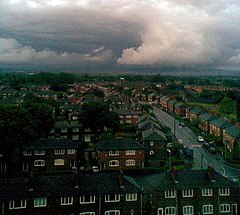Newton Heath
| Newton Heath | |
|---|---|
 A view over Newton Heath |
|
| Newton Heath shown within Greater Manchester | |
| OS grid reference | SD878004 |
| • London | 163 mi (262 km) SSE |
| Metropolitan borough | |
| Metropolitan county | |
| Region | |
| Country | England |
| Sovereign state | United Kingdom |
| Post town | MANCHESTER |
| Postcode district | M10/M40 |
| Dialling code | 0161 |
| Police | Greater Manchester |
| Fire | Greater Manchester |
| Ambulance | North West |
| EU Parliament | North West England |
| UK Parliament | |
Newton Heath is an area of Manchester, England, 2.8 miles (4.5 km) north-east of Manchester city centre and with a population of 9,883.
Historically part of Lancashire, Newton Heath was formerly a farming area, but adopted the factory system following the Industrial Revolution. The principal industry in the area was engineering, although many were employed in the mining and textiles industries in the thriving areas of Clayton Vale and Bradford.
Newton Heath takes its name from Old English and means the "new town on the heath". The heath in question formerly stretched from Miles Platting to Failsworth, and is bounded by brooks and rivers on all four sides — the River Medlock, Moston Brook, Newton Brook and Shooters Brook.
Manchester United F.C. has strong links with the area, having been formed from the Newton Heath Lancashire and Yorkshire Railway Football Club.
French Huguenots settled in the area in the 16th century to avoid continental persecution, and brought cotton and linen weaving and bleaching skills with them. The arrival of textile mills saw Newton Heath's cottage industry change forever into a fully mechanised mass production system – in 1825 Newton Silk Mill (which exists to this day) was built and the Monsall Silk Dye Works followed soon afterwards.
The Rochdale Canal made movement of raw materials and finished products a practical reality. Later came other industries, including a soap works, Elijah Dixon's match manufacturing factory, and rope works as well as engineering and glass making works. Many small back-to-back low cost houses were built to house the new migrant work force. Thus was Newton changed irrevocably from a farming area into an industrial one.
...
Wikipedia

